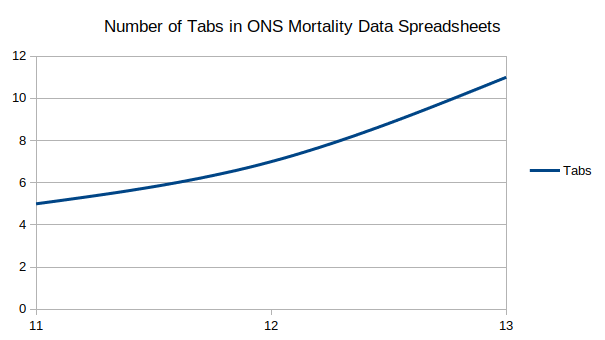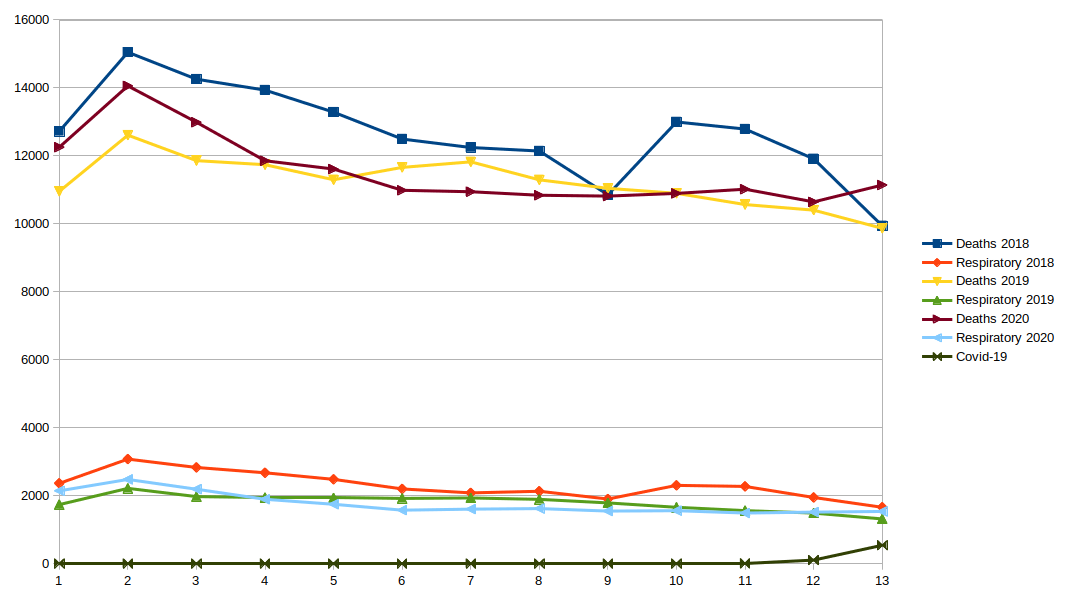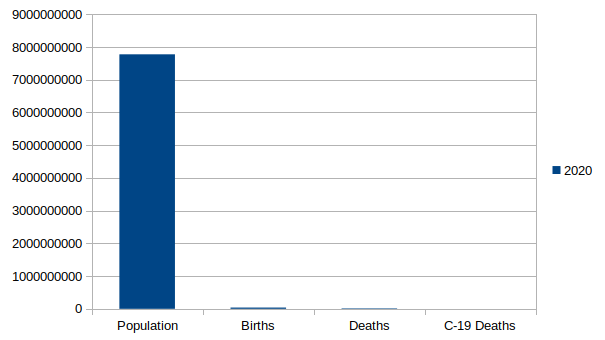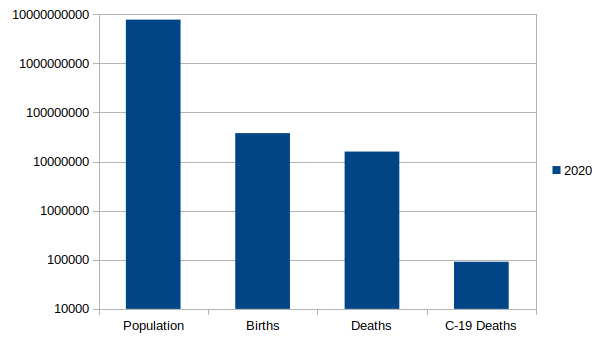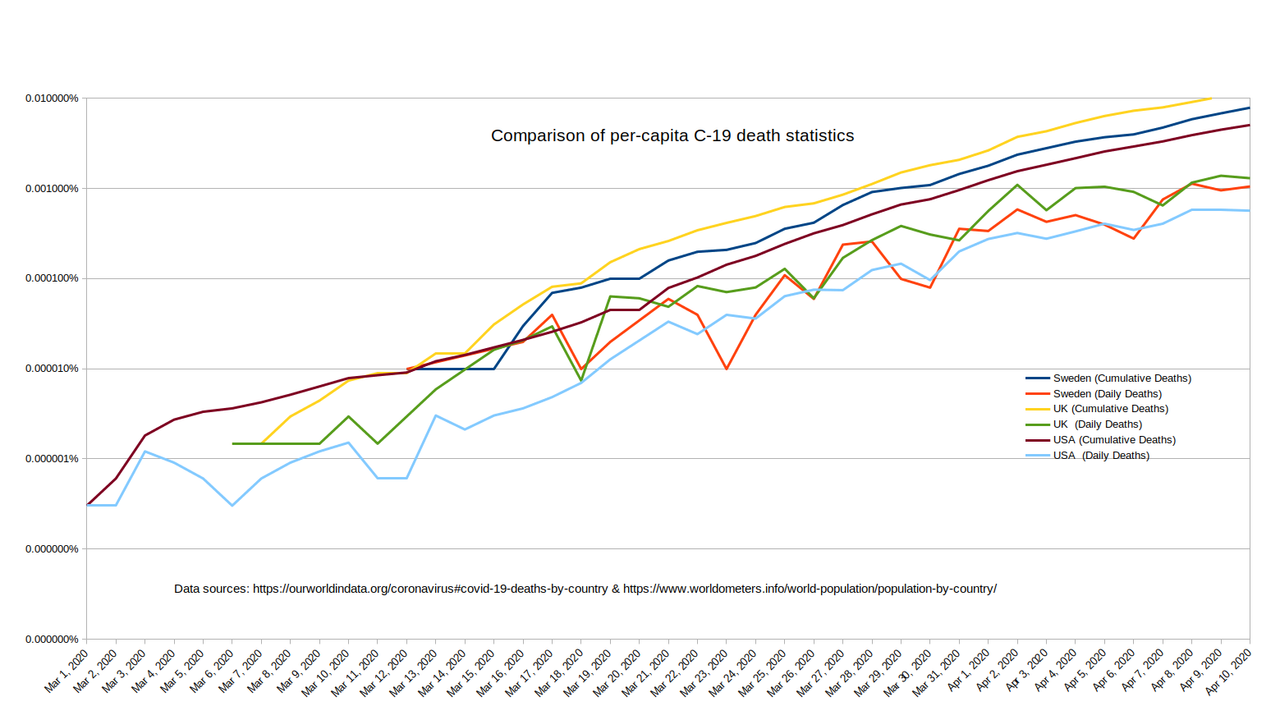Re: Japan, no idea here either. With them it's so easy to imagine either extreme, that they're better at this than everyone else, or that they're better liars than everyone else.
Here's an attempt to get a hold of the numbers in New York. (Yeah yeah, I can see the masthead too.)
Deaths in New York City Are More Than Double the Usual TotalBy Josh Katz and Margot Sanger-Katz
April 10, 2020
https://www.nytimes.com/interactive/202 ... -city.htmlNew York City has displayed an average death rate in of 159 a day in recent years and a typical range between 4,000 and 5,000 a month over the last 20 years. There has been a very regular cycle in which the annual peak always comes in the late winter flu season and never gets more than a small margin above 5,000, at least since the winter of 2000 when it exceeded 6K in the peak month. (The only exception in this pattern was in September 2001, which we can exclude for obvious reasons.)
The city (five boroughs) was site to at least 9,780 deaths in the month ending April 4, or
5,330 more than expected based on this month's numbers ranging back over the 20 years. The number so far accounted as C19 deaths is only 3,350, which suggests a major undercount. (Assuming it's not also the other flu.)
Note that this was as of April 4 and does not include the six days of April 5-10, which have been the peak days with deaths at 600-800 daily in New York State (and more than half of these daily in the five boroughs), and this still with possible undercounts due to deaths at home.
All this being said, and given IANAE or anything other than a rank amateur, I think the leveling of the "case" numbers over recent days indicates this is going to be the peak level, though the plateau may go on for some days yet.
Analysis of the following (and the source bases linked) invited!
NYT wrote:The measurements in our chart rely on a New York Times analysis of provisional data from the National Center for Health Statistics, along with historical data from the C.D.C. and the city’s Department of Health. They capture the number of people who died within the city limits in each month since January 2000. The historical numbers include some small adjustments because of differences in how the two public health organizations measure deaths in the city.
The recent numbers are most likely an undercount. Even in normal times, death certificates take time to be processed and collected, and complete death tallies can take weeks to become final. This is especially true for cases involving coronavirus. “Covid deaths all have to be manually coded,” said Bob Anderson, chief of the mortality statistics branch at the C.D.C.’s National Center for Health Statistics, adding that death counts from New York City typically lag actual deaths by 10 or 11 days.
But even if the current count is perfect, roughly 9,780 people have died of all causes over the past month in New York City, about 5,000 more than is typical.
The numbers for the last two weeks of the period are even more stark: nearly 7,000 dead, more than three times as many deaths as would normally be expected this time of year.
As our charts show, deaths are strongly seasonal: On average, more people die in winter and fewer in summer. These fluctuations aren’t just related to the flu. In a typical year, the vast majority of the variation in mortality is driven by seasonal variation in the number of heart disease deaths.
But the deaths over the last month dwarf what would be expected from seasonal variations, and look more like a mass casualty event. The city’s medical examiner’s office is holding bodies in refrigerated trailers outside of hospitals. City emergency medical technicians are declaring deaths in homes and on the streets instead of bringing people to hospitals.
Robert A. Jensen, the chairman of Kenyon International, a firm that helps communities respond to major disasters and attacks, said the scale of the event would leave a lasting mark on the city.
“The reminders will be cemeteries,” he said, describing European burial areas devoted to victims of the 1918 Spanish flu epidemic. “There will be whole sections that have March, April and May 2020.”
Methodology
Our calculations rely on four slightly different measurements of deaths in New York City over the past two decades.
Two C.D.C. data sets measure deaths in close to real time. One is the FluView system, which provides weekly all-cause mortality figures to help local officials evaluate flu seasons. The second is a new coronavirus dashboard of provisional death counts, which provides partly counted totals for all deaths that happened from Jan. 26 through the most recent Saturday. Both of these data sets measure all deaths that occur in the city.
The city’s health department also measures deaths that occur in the city, and provided monthly data for 2010 through 2017. We supplemented these numbers with data from the C.D.C., which keeps statistics on deaths among all people whose homes are in the city, regardless of where the deaths occur. The resident and nonresident numbers differ by small but consistent ways over time, so we adjusted the C.D.C. figures to approximate the city health data.
The exception was September 2001, when many more nonresidents died in New York City than in a typical September. To adjust for this, we added all nonresident World Trade Center deaths to the total from the C.D.C data.
In general, provisional data on deaths understates the final totals because it takes time for local authorities to count and report all deaths to the C.D.C. This means that our recent total, as high as it is, is probably smaller than the real number.
To partly account for this lag, we added the 1,396 coronavirus deaths that occurred through April 4 that have been reported by the city, but that have not yet been added to the C.D.C. data, to the total deaths counted figure.
Also:
https://www.nytimes.com/2020/04/10/nyre ... pdate.htmlNumber of Virus Patients in I.C.U.s Starts to Fall in New York
The figure decreased for the first time since the outbreak began, providing more evidence that the curve of infection is flattening, but deaths remain high.
April 10, 2020
April 10 counts for New York State:
TOTAL CASES
170,512
DEATHS
7,844
The number of virus patients being treated in intensive care units across the state fell by 17 people from the day before, Gov. Andrew M. Cuomo said.
Seventeen may be a very small number, but its significance is great. Just a week ago, the number of intensive-care patients — a vast majority of whom are on ventilators — was growing by more than 300 a day.
The promising news was tempered by the chilling fact that another 777 people had died of the virus on Thursday. But another important indicator, the growth of the number of virus patients in hospitals, has slowed so sharply that it has taken the health authorities by surprise. [...]
It is a surprise unless they had stuck with the initial more sober projections, back when C19 was supposed to peak in NYC during the week starting April 5. But of course acquiring the maximum possible reserves in beds and equipment was wise, and they are also not the ones to blame, at least primarily, for general response measures that may or will prove to have been excessive, counterproductive, or crazy.
Usual caveats for 777 (state number, daily, who knows if it is total or diagnosed, various reasons to expect both undercount and overcount).
As we saw in the first article, excess deaths, i.e. total deaths from all causes compared against expected numbers based on the past, are surely the most reliable indicator of C19 impact whether direct or collateral.
.




